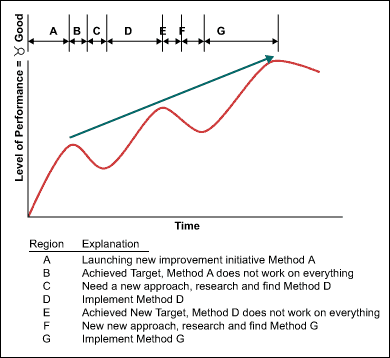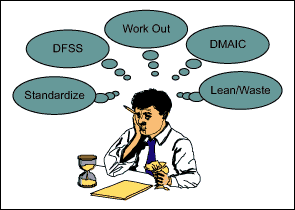
For more than 30 years, global competition has driven businesses to seek new and better ways to be competitive in the marketplace. Some companies, in searching for the best ways to make their businesses profitable, have gravitated to the “latest and greatest” management ideas. In the extreme, business leaders have tried one new idea after another. And while some of these methods had positive effects and provided some gains, the major breakthrough never materialized. More often than not, the reason for these disappointing results was that the methods were implemented as stand-alone activities and not fully integrated into the business.
There needs to be a better way. Businesses cannot afford to continue trying one new thing after another without seeing long-term sustainable improvements. Businesses require a peak-to-peak mentality, where the organization successfully moves to each new improvement level without going through the valleys of continually implementing a new approach.

What is needed is an integrated approach that works within the organization’s culture to drive business-wide improvement. A company needs to use what works for the business, based on the situation. Any artisan knows that using the right tool is critical. Management schools teach this to business leaders as well – use the right tool for the right situation, i.e. situational leadership. It is the same for business improvement – apply the correct methodology for the situation.
Basics of Six Sigma
Six Sigma is a philosophy of continuous improvement. It is a philosophy of data-driven, fact-based decision-making in which decisions are tied to the short- and long-term corporate objectives. Six Sigma incorporates three methodologies:
- Process Management, which is the control and management of cross-functional processes to meet business goals. It requires having systems in place for data collection, decision-making, and initiating improvement efforts.
- DMAIC, which is the logical problem-solving methodology to improve existing processes so that the outputs meet customer requirements. Typically, when organizations think of Six Sigma, they are thinking of DMAIC.
- Design for Six Sigma, which is the methodology that is used when there is a need to design new processes and/or products to meet the customer’s needs.
There is a way to find an integrated approach and the right tools for nearly every situation. And here is where the Six Sigma approach comes in.
To understand what Six Sigma is, it is first necessary to understand what it is not. It is not a program. A program has a beginning and an end. When Six Sigma is deployed correctly, it does not end; it becomes a way of running the business. Six Sigma is not just about solving problems and incrementally improving processes through projects that use the DMAIC (Define, Measure, Analyze, Improve, Control) method – although that is one of its key elements. And Six Sigma is not the be-all and end-all for business improvement.
Then What Is Six Sigma?
There are many perceptions of what Six Sigma is. Different companies have adopted their own definition. Six Sigma is a strategic initiative that drives performance at all levels of a company, using data from the company’s processes to manage the business. Based on how the processes are performed, the company decides what needs to be improved. This component of Six Sigma is called process management.
Six Sigma also is an integrated business philosophy – a goal to strive toward. It is something that helps leaders at all levels of a business make decisions. It helps develop the organization’s skill set. It drives up the value of the organization by utilizing resources on the major issues identified by process performance.
Unfortunately, this is not how Six Sigma is being employed in many organizations. Six Sigma has become synonymous with a tactical focus on improvement projects using the DMAIC methodology. As such, Six Sigma is viewed as a short-term program and the power of the philosophy is never realized.
So What Is a Business Leader to Do?
As business leaders attempt to lead their organizations toward improvement, they grapple with the confusing task of choosing a method for achieving that goal. What they need to do is adopt a strategic philosophy of driving performance improvement. The question then becomes which approach will best carry out that philosophy.
 With all of the press about Six Sigma, should the business leader just move ahead and implement it? Not necessarily. It is not the name that is so important. For example, Six Sigma was the name that was used at General Electric to strategically focus the organization. Everyone at GE understood the goals of the organization. Everyone understood the tools within Six Sigma that were used to achieve the goals – DMAIC, Design for Six Sigma, process management, Work-Out and others. It worked at GE, and the GE way may or may not work for other organizations.
With all of the press about Six Sigma, should the business leader just move ahead and implement it? Not necessarily. It is not the name that is so important. For example, Six Sigma was the name that was used at General Electric to strategically focus the organization. Everyone at GE understood the goals of the organization. Everyone understood the tools within Six Sigma that were used to achieve the goals – DMAIC, Design for Six Sigma, process management, Work-Out and others. It worked at GE, and the GE way may or may not work for other organizations.
A better way is to put into place a strategic initiative that takes into account the people, history and culture of the organization. Give the initiative any name. Some companies that are being successful with Six Sigma have taken the tools of Six Sigma and put them beneath their own banner. Johnson & Johnson is implementing “Process Excellence.” The company’s goal is to achieve excellence in its field. Within Process Excellence, the company has identified the goals and objectives that define what Process Excellence means and has determined which tools will get them to those goals. The tools include, DMAIC, Design for Six Sigma, Lean, process management, Work-out, Kepner-Tragoe and many others. Johnson & Johnson has learned that taking the time to identify the right tool for the situation is critical.
The key is that the company is implementing strategically. It is not implementing a methodology. It is implementing an improvement strategy that calls upon the appropriate methodology, based on the situation.
Conclusion: Do More Than Mimic
Business leaders must determine what makes sense for their organization. What is important is to remember that the focus is on improving and sustaining the gains – not which method is being used. For improvement efforts to be successful, there needs to be a systematic approach.